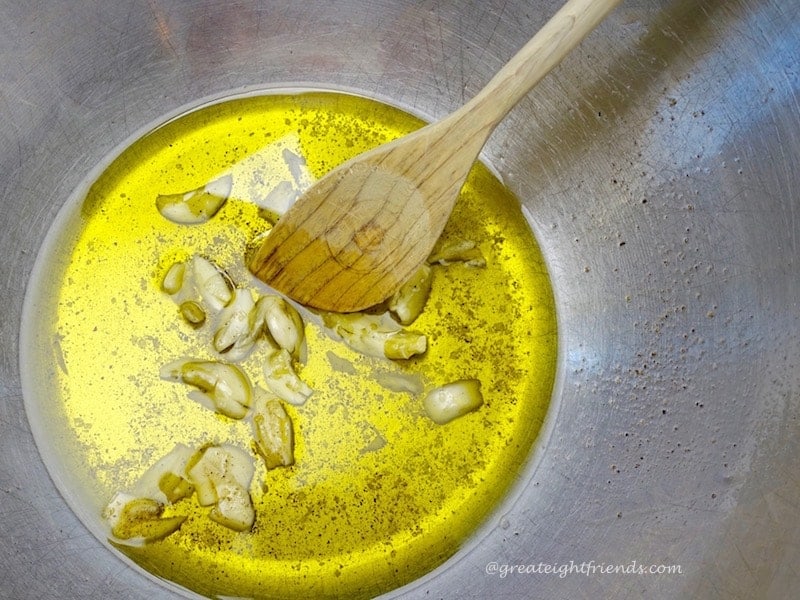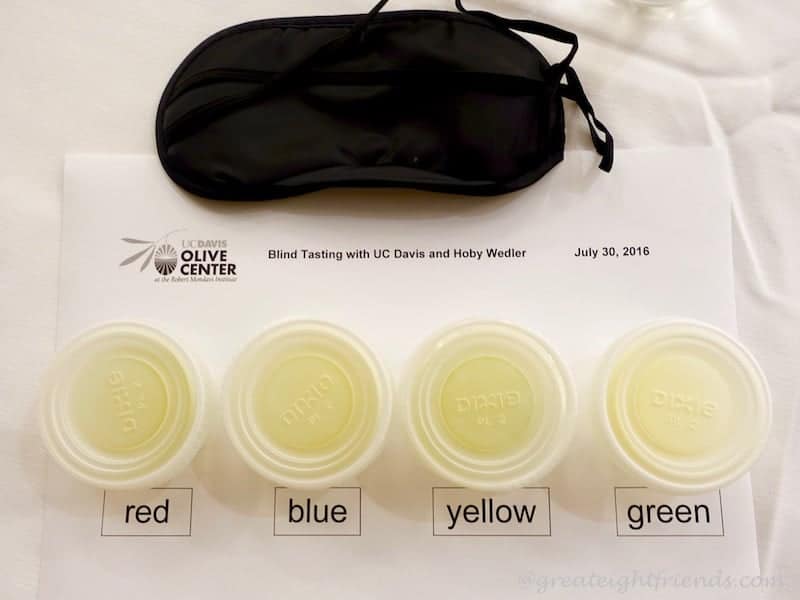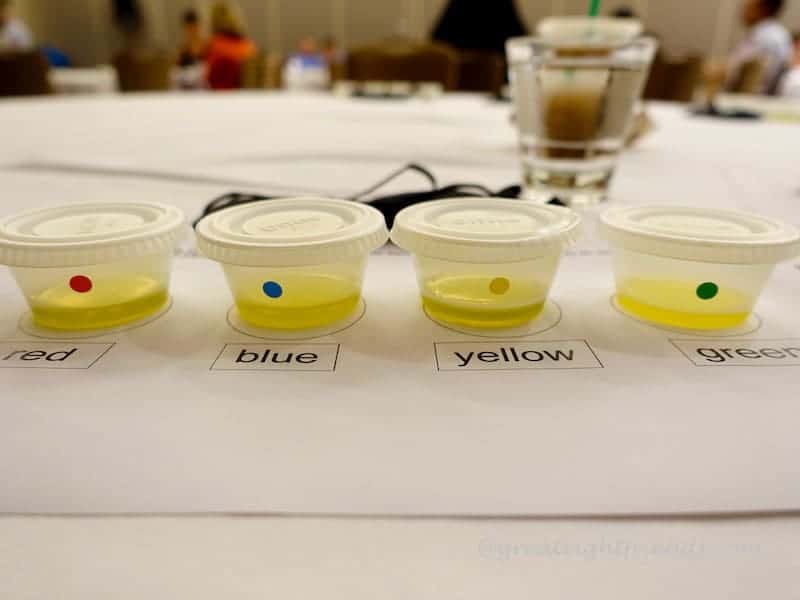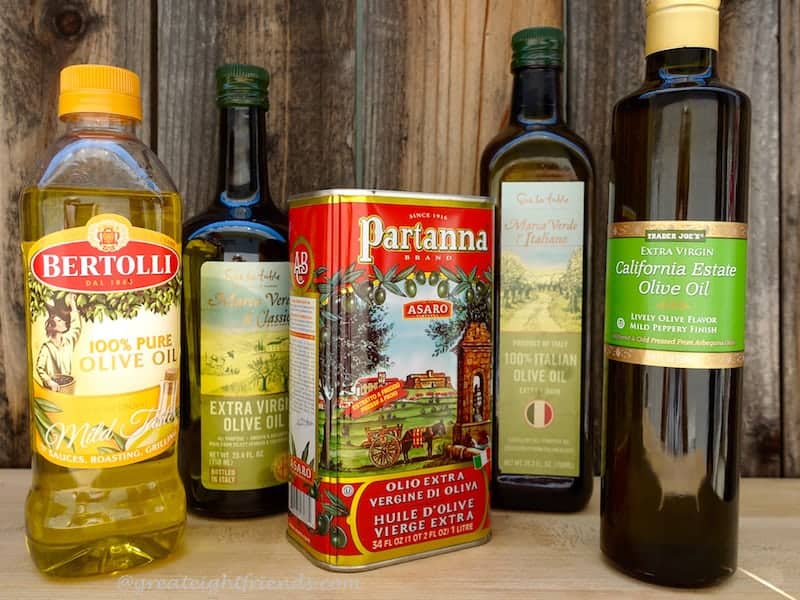Olive Oil - the myths dispelled. Learn how to determine which olive oil you should buy, how long to store it and other interesting facts.
 Olive Oil —
Olive Oil —
When I was a girl, olive oil was this mysterious liquid that resided in a small dark bottle in the back of our pantry and traveled with us from base to base each year as my father was transferred. I don't recall my mother ever using it for anything. When I moved away as an adult I cooked mainly "American" food and used vegetable oil.
Then I met and married my 100% Italian husband, who repeatedly told me that his mom and grandma were both gourmet cooks. Well, not to be outdone, I had to step up to the plate. (That would be my competitive personality butting into my life!)

Over the past 27 years of wedded bliss, I have improved my cooking skills gr8-ly and now mainly use olive oil in my kitchen. So when the opportunity presented itself to attend a blind tasting of olive oil at the 2016 International Food Blogger Conference in Sacramento, I was excited. The session was hosted by the UC Davis Olive Center's Dan Flynn and Sensory Scientist Hoby Wedler (Just Google Hoby Wedler, you'll be glad you did). Oh the things I learned and the myths these two gentlemen dispelled!
One of the most important things we learned from Dan and Hoby is that olive oil is fruit juice! That's right, the olives are first crushed and then spun in a centrifuge and this is how the oil becomes separated from the fruit. Good olive oil is not "processed" it is extracted from the fruit.

Every participant had a blindfold and four small cups, each containing a different olive oil.There are 3 descriptors used throughout the industry to determine the quality of olive oil:
- Fruitiness - similar to tasting wine, some of the descriptive words are grassy, herbaceous, green apple, ripe apple, tropical, buttery, melon (green or ripe), etc.
- Bitterness - olives are a naturally bitter fruit, so some bitterness shows that the olive oil is fresh and healthy. It should be balanced with the fruitiness.
- Pungency - the peppery, spicy or piquant sensation, an indicator of the healthy anti-oxidants.
Our instructions were to don the blindfolds, Hoby wanted us to use only one sense, our sense of smell. Too often we look at the color of olive oil and immediately make a determination based on what it looks like. But, the first myth that was dispelled by Dan is that color has nothing to do with the quality or flavor of olive oil.

Once we were all "blind" 3 oils were passed around for us to smell. (Passing oil while blindfolded was a trick, but we managed!) The passed oils were rancid, fusty and musty. Hoby wanted us to be able to identify those "bad" smells. We then uncovered and smelled the first "good" oil and had to think about the notes we could identify. Then we tasted the oil, Hoby encouraged us to really let it coat all parts of our tongues to get every sensation. Was it heavy feeling? Was it oily? Was is sweet or bitter or peppery? What flavors came to mind? And we did this with each of the four oils.Tasting different oils may not be practical to do at home, but there are some stores that offer olive oils to taste, and it is a good exercise. You will quickly find your favorite.
One important thing to remember is, unlike wine, which generally improves with age, oil does not improve with age. The 3 descriptors for a "bad" oil are:
- Rancidity - all oils will turn rancid and this can easily be detected through smell and taste. If the oil feels very greasy or has a putty flavor, or if it just doesn't taste good to you, then it is probably rancid.
- Fusty - This indicates an older fruit, a fruit that sat around a couple days too long being being turned into oil.
- Musty - we all know that musty, moldy taste, and it comes from just that, olives that have "gone 'round the bend" and turned moldy.
Here are the my take-aways from this very informative session:
Know the taste of fresh - If you get your extra-virgin olive oil home and it doesn't taste good, return it.
Harvest Date - The more recent the harvest date, the fresher the oil.
Use it up - Only buy the quantity of olive oil that you can use up within 2 months of opening. Clearly, that small dark bottle in the back of my mother's pantry didn't need to travel with us...it should have been tossed!
Protective Packaging - Only buy olive oil that is packaged in tin or in dark glass bottles. Light degrades the oil and it will turn rancid quickly. (In the photo above the Bertolli oil is not well-packaged.) And keep it in a cool dark place. Mine is on the bottom shelf of my pantry.
Quality Seal - California Olive Oil Council (COOC); North American Olive Oil Association (NAOOA); if it's European oil, look for the DOP, Denominazione d'Origine Protetta or, in English, PDO, Protected Designation of Origins.
You CAN cook with Extra-virgin olive oil - A good quality EVOO should withstand temperatures of 375º to 400º F. So go ahead...use extra virgin olive oil when you make that veal piccata!
Right now I have 4 different olive oils in my pantry (bought before this class) and none of them have either a harvest date OR a quality seal. I need to start cooking to use up what I have so I can follow these guides with any new oil I buy!
Some Gr8 Recipes
Send us a picture if you try any of our Gr8 recipes. We would love to share!
Be a Gr8 Friend!


 Olive Oil —
Olive Oil —
Anna
Ahhh, thank you for the kind comment, Stephanie! It was one of our favorite sessions, as well. I hope we can meet you next year!
Stephanie Chavez
I love this post so much. It was one of my favorite sessions at IFBC. That (and the swag) made the trip worth every penny.
Anna
Hi Lon! Who knew, right?
Anna
Thanks Debi, it was a Gr8 lesson...we learned a lot!
Claudia Kerns
Thank you so much!! This was truly lovely!!
Debi W
Thanks Anna, Great educational information. I'm going to start taking your pointers to heart now that I know.